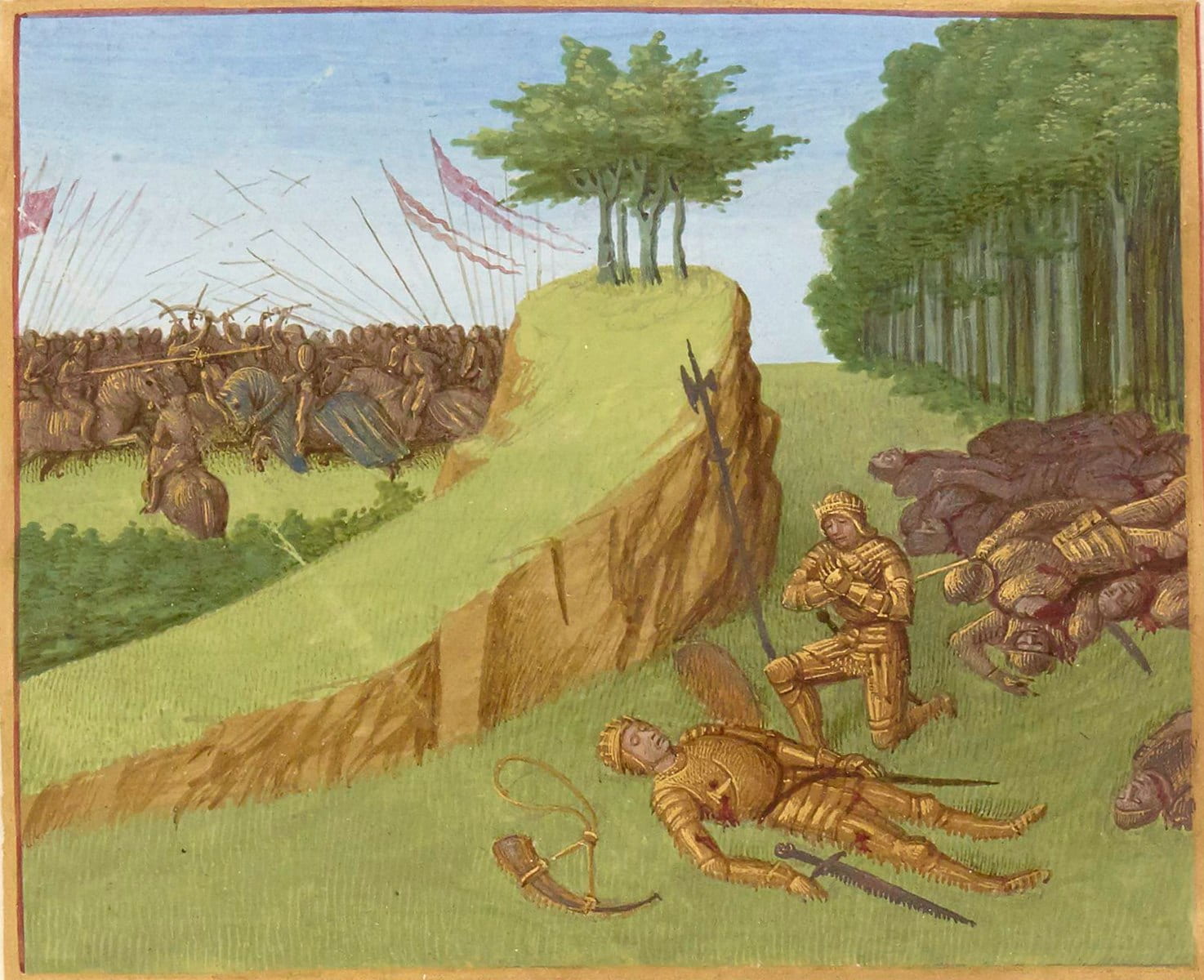France
Composed: ca. 1040-1115 CE
Earliest extant manuscript: ca. 1129-1165 CE
Anonymous
The Song of Roland
(La chanson de Roland)
Halt sunt li pui e li val tenebrus… the high hills and foreboding valleys of the Pyrenees pass at Rencesvals reverberate with visual, visceral and sonic intensity in The Song of Roland, a tale of epically proportioned yet carefully contained betrayal, hubris, vengeance, and religious conflict.
Its narrative probes the nature of heroism and limits of contemporary ideologies, where tragic events both celebrate and call into question key values of medieval society surrounding reputation, service to a lord, and Christian proselytising. Indeed, part of the Roland’s enduring appeal perhaps lies in the tensions between its assertion that ‘pagans are wrong, and Christians are right’ yet the very fallibility of the heroes attempting to uphold this claim: after all, the main battle of the text narrates the defeat of renowned warriors caused by a betrayal from within their own community, even if this is framed as a larger form of Christian sacrifice.
Perhaps the most well-known work of all medieval French literature, let alone of medieval French epic or chansons de geste, The Song of Roland was likely put into written form during the eleventh century and its many versions and afterlives are testament to the story’s enduring popularity. As Joseph Duggan notes, 10 medieval versions survive in different European languages, from the Middle High German Rolandslied (mid twelfth century) to the Old Norse Karlamagnús saga or Occitan Ronsasvals. This is not to mention the later incorporation of the events of Rencesvals into works such as the thirteenth-century Grandes Chroniques. The most famous version of the Chanson de Roland, known as the Oxford text, is written in just over 4000 lines of Anglo-Norman French grouped into laisses and contained in manuscript Bodleian Library, Digby 23. While it represents one of the earliest works of Old French literature and displays both a certain technical prowess and intricate construction, the Oxford text is in fact merely one of several medieval French versions that survive: there are six other French refashionings in substantial manuscript form (known as Venice 4, Châteauroux-Venice 7, Paris, Cambridge, Lyon) alongside three further fragments. In its various forms, this epic loosely draws upon real historical events and people – in 778 there was a Battle of Rencesvals Pass involving the rear guard of Charlemagne’s army retreating from Spain. However, the attacking forces in the eighth century were the Basques, not the Saracens, and references to a man named Roland in contemporary documents suggest that he was a northern border marshal rather than the heroic nephew of the emperor. In this respect, as with many chansons de geste, we have a certain amount of poetic license in the medieval French narratives that survive, as well as a certain amount of influence from eleventh- and/or twelfth-century social structures and customs.
The Oxford version’s storyline:
The narrative opens with a council formed of the Frankish King and Emperor Charlemagne (Charles) and his advisors (peers). Charles has been occupying Muslim Spain for seven years (Muslim peoples are referred to as Saracens, or pagans in this work) and has conquered everywhere except the city of Saragossa, which is held by the Saracen ruler King Marsile. Things have reached a bit of a stalemate. Marsile is advised by his baron, Blancandrin, to offer gifts to Charles, with the promise that he will convert to Christianity, and the guarantee of hostages who can be killed if he breaks his word. In return, Charles is asked to withdraw from Spain. When Blancandrin brings this message to the Franks, Charles asks for an emissary to go to Marsile and discuss his terms. Having had his own application turned down, Roland, Charles’s nephew, nominates his stepfather, Ganelon, for this dangerous mission. Ganelon leaves, angry with Roland, and plots with Blancandrin and then Marsile to attack the rear-guard of the Christian troops, which will be led by Roland once he has been nominated by Ganelon.
As the rear-guard goes through the mountain pass at Rencesvals, Oliver, Roland’s companion, sees the approaching Saracen army and urges Roland to blow his horn, the olifant, which will summon Charles and the rest of the troops back to help. Roland refuses. The rear-guard fights bravely: Marsile is fatally wounded and loses his right hand in the battle, but the Christians are decimated by the more numerous Saracen troops. When there are only 60 Frankish knights left, Roland finally decides to blow the horn although Oliver now attempts to dissuade him from doing so. Roland blows the horn with superhuman strength and bursts his temples – an injury that soon kills him.
Charles and his troops arrive too late to save anyone. He swears revenge, and leads ten divisions against the Saracen emperor, Baligant, who has since arrived in Spain from Babylon to aid his ally Marsile. Baligant is defeated and Saragossa is captured. Roland and the other peers are given Christian burials, and the Franks return to France. Upon learning of Roland’s death, Aude, his betrothed, and Oliver’s sister, dies of grief. Ganelon is tried for treachery, found guilty, and dragged apart by wild horses. As the text ends, Charles receives a message from the angel Gabriel telling him of trouble elsewhere in his empire, and Charles laments his hard life.
Appropriated by nationalist agendas of the nineteenth century and celebrated as the epitome of Frenchness and the ideals of ‘Fair France’, The Song of Roland nonetheless leaves ideas of nation unstable: Charlemagne’s men are not all from France but encompass French, German, Burgundian, and Bavarian groups, to name just a few (laisses 220-227). Similarly, despite the seemingly absolute emphasis on Christian triumph, the Saracen community presented features positive vassals (Blancandrin) and noble warriors (Margarit) alongside racialised and racist portraits. In a sense, the Oxford text’s ending resists a neat resolution, with Ganelon’s memorable execution raising questions about justice and vengeance and Charlemagne facing a seemingly interminable struggle to fulfil his holy duty. Here, Christian victory is hard won and fleeting, heroes are lost, and lines of difference blurred as fast as they are asserted.
Victoria Turner
University of St Andrews
Resources
Manuscript:
Catalogue record of manuscript in Medieval Manuscripts in Oxford Libraries.
Old French editions:
Brault, Gerard J., trans. La Chanson De Roland: Oxford Text and English Translation. Pennsylvania State University Press, 1984.
English translations:
Brault, Gerard J. Song of Roland: An Analytical Edition: Introduction and Commentary, Penn State Press, 2010.
Newth, Michael A., trans. The Song of Roland: a New Verse Translation with Introduction. Italica Press, 2011.
Digital facsimile of the earliest manuscript.
Painted enamel, “Roland,” on display at the Met Cloisters, New York.
Lithograph, “Ritter Roland,” National Gallery of Art, Washington, D.C.
“Roland at Roncesvalles,” by Odilon Redon.
“The Emperor Charlemagne finds Roland’s Corpse after the Battle of Roncevaux,” Jean Fouquet, c. 1460.
“Childe Roland to the Dark Tower Came,” Briton Riviere, 1917.
“Childe Roland to the Dark Tower Came,” Thomas Moran, 1859 – https://www.wikiart.org/en/thomas-moran/childe-roland-to-the-dark-tower-came-1859
“Illustration to the Song of Roland,” Heorhiy Narbut, 1903.
Various works of art depicting the Battle of Roncesvalles Pass.
Eight Stages of the Song of Roland in one picture; Grandes Chroniques de France, St. Petersburg, Ms. Hermitage. fr. 88: (Niederl. Burgund, Mitte 15. Jh., Exemplar Philipps des Guten), folio. 154v, Simon Marmion, 15th century.
Chante-moi Roland: la mort de Roland. Camille Fritsch (chant), Pauline Chiama (vièle), Elouan Quelen (percussions). Conservatoire Supérieur National de Musique et de Danse de Lyon, March 2021.
Daron Burrows performance Laisse 1 of Chanson de Roland.
“Song of Roland: The Arabic Version.”
“Chanson de Roland,” song by German band dArtagnan.
“The Battle of Roncevaux/Roncisvalle.” Sicilian Puppet Theater. In Italian. eBOIARDO (The Epics of Boiardo and Other Italian Authors: a Research Database Online)
Roncisvalle. By Romolo Fioroni. Epic Maggio of the Tuscan-Emilian Apennines. In Italian. Rossena (RE), Italy, 2002. eBOIARDO (The Epics of Boiardo and Other Italian Authors: a Research Database Online)
Shortened dramatization of the Song of Roland.
“The Birth of Romance in England.” Podcast, University of Oxford.
The following questions are geared toward a discussion of the Song of Roland in the context of the upper-level undergraduate course Nobility and Civility: East and West (Columbia University global core).* A syllabus of the course can be found here.
The Song of Roland, translated by Glyn S. Burgess (New York: Penguin, 1990). Stanzas 1-90 (pp. 29-65), 128-137 (pp. 83-87), 164-187 (pp. 99-111), 268-298 (pp. 144-156)
Compare King Marsile to Charlemagne. What is the relationship of each to his barons? What is their decision-making process? Take note in particular of the council scenes.
Beyond the rulers, how are the “pagans” represented? Do any characteristics set them apart from the Christians and what do they have in common?
How does the dispute between Roland and Oliver about whether to sound the olifant reveal their different views on what it means to be a good vassal? What are the motivations for each position and why does each paladin change his mind? Does the poet do anything to sway your own opinion in the matter on either occasion? In short, which position do you find more justified and why?
What is Ganelon’s motivation for his treacherous actions? Can you compare him to Garsivaz in Ferdowsi’s Legend of Seyavash? Pay particular attention to his trial, including Charlemagne’s accusation and Ganelon’s defense. What is the basis for the peers’ verdict? What brings about justice in the end?
Do the female characters – Roland’s finacée Aude and Marsile’s queen Bramimonde -exhibit qualities that could be linked to nobility or civility? What role do they play in the plot?
What do you make of Charlemagne’s final vision and his reaction to it?
What are the poem’s ethical values and political purposes?
Jo Ann Cavallo (Columbia University)
*This two-semester course was designed through the Faculty Workshops for a Multi-Cultural Sequence in the Core Curriculum (Heyman Center for the Humanities, 2002-2009), directed by the late Wm. Theodore de Bary, at Columbia University.

